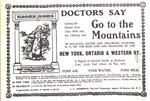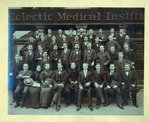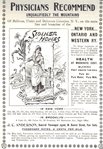Phoebe Low graduated from medical school in 1872, hung out her shingle in Liberty, NY and started treating the sick. That made her one of about 525 female doctors in the country. And she was regarded …
Stay informed about your community and support local independent journalism.
Subscribe to The River Reporter today. click here
This item is available in full to subscribers.
Please log in to continue |




Phoebe Low graduated from medical school in 1872, hung out her shingle in Liberty, NY and started treating the sick. That made her one of about 525 female doctors in the country. And she was regarded highly enough to be eventually elected treasurer of the New York Eclectic Medical Society, said Sullivan County historian John Conway.
Dr. Low was part of a medical community that was a mainstay of rural medicine for years and accepted both white female and African American doctors.
“The Eclectic Medical movement was thriving in the United States throughout most of the 19th century and into the first couple of decades of the 20th century, and at [its] height at the turn of the 20th century, [there were more than] 30 medical schools throughout the Eastern and Midwestern U.S,” said Forestburgh resident and clinical herbalist Richard Mandelbaum. Sullivan County, he said, boasted a county chapter.
“By ‘eclectic,’ they meant that they were pragmatic, using whatever was most effective but also with the least toxicity. Most of what they used were herbal remedies,” continued Mandelbaum.
Non-Eclectic medical practices included bleeding, purgatives and surgery, which was performed without anesthesia until the mid-19th century, when ether came into use; we aren’t counting biting sticks or getting drunk as anesthesia. And never mind the lack of sanitation, which killed people too. (Go ahead and look up childbed fever.)
It’s no wonder that people turned to eclecticism. “They preferred nourishment to bleeding and chose among several different medical traditions to find the best remedy for each patient,” Mariann Garner-Wizard writes on the American Botanical Council’s site.
And the Eclectics may have particularly appealed to rural residents.
“I think Sullivan County was more or less a typical rural county,” Conway said. “There were very few well-trained doctors of any kind in America back then, and most of them were in the big cities—Boston, NYC, Philadelphia.”
Rural Americans believed in rugged individualism, in being self-sufficient and relying on themselves first, Conway said. That included treating themselves when ill or hurt and calling the doctor only when absolutely necessary. “The Eclectics presented a choice and a much less dictatorial practice that could be tailored to the individual and to the place.”
For instance, plants in New York were not the same as plants in Georgia, so remedies had to be different. Plus, Conway added, the practitioners could choose their own techniques.
What happened to the Eclectics? Many people connect their demise to the release of the Flexner Report in 1910, which led to medical schools as we know them today (www.bit.ly/TRRmedicalschools) and recommended science and research-based knowledge to underlie practice, according to the Yale Journal of Biology and Medicine.
Some of the Eclectic schools slowly faded away; others fell victim to unscrupulous managers. Some turned into diploma mills, which damaged the reputation of the practice. In 1939, the Eclectic Medical Institute in Cincinnati, the last school, closed.
But the Eclectic approach—individualized care, herbal remedies—has lingered. The more that is learned about genetic factors in health and in the way people respond to medications, the more individual medicine gets. Plus, in the United States, 38 percent of adults and 12 percent of children use traditional medicine, which includes herbs (www.bit.ly/TRRherbs).
The Eclectic approach didn’t die in 1939. It hasn’t even gone away.
Thanks to the Lloyd Library of Cincinnati, OH, for information used in this story.
Comments
No comments on this item Please log in to comment by clicking here